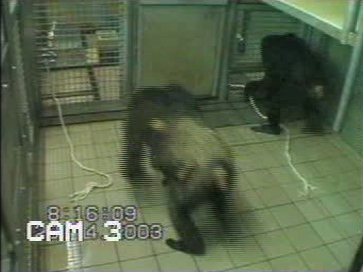Cooperation and helping behavior may be intentional.
 Organsims with open behavior programs may thus engage in cooperative and helping behavior, quite apart from genetic reasons. For example, chimpanzees in a novel laboratory setting that enables them to work together to secure food, collaborate. Given a choice, they recruit chimps with the best history of cooperation, indicating their understanding of cooperative behavior (Melis, Hare & Tomasello 2006).
Organsims with open behavior programs may thus engage in cooperative and helping behavior, quite apart from genetic reasons. For example, chimpanzees in a novel laboratory setting that enables them to work together to secure food, collaborate. Given a choice, they recruit chimps with the best history of cooperation, indicating their understanding of cooperative behavior (Melis, Hare & Tomasello 2006).
[View VIDEO of cooperative and intolerant chimps in testing situation (depicted above).]
Similar behavior has also been documented in the crow-like rooks of Europe (Corvus frugilegus) (Holden 2008; Seed et al 2008). Biologically, one distinguishes sharply between genetic and psychological levels of helping (Sober and Wilson 1998).
Cooperation at the psyhcological level is still susceptible to cheating or defection. However, the problem is transformed because individual organisms have the potential to learn—and to identify individual cheaters. The ability of organisms to interact leads biologists to consider the social level more fully.